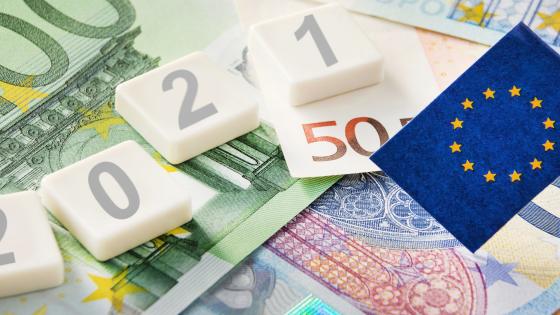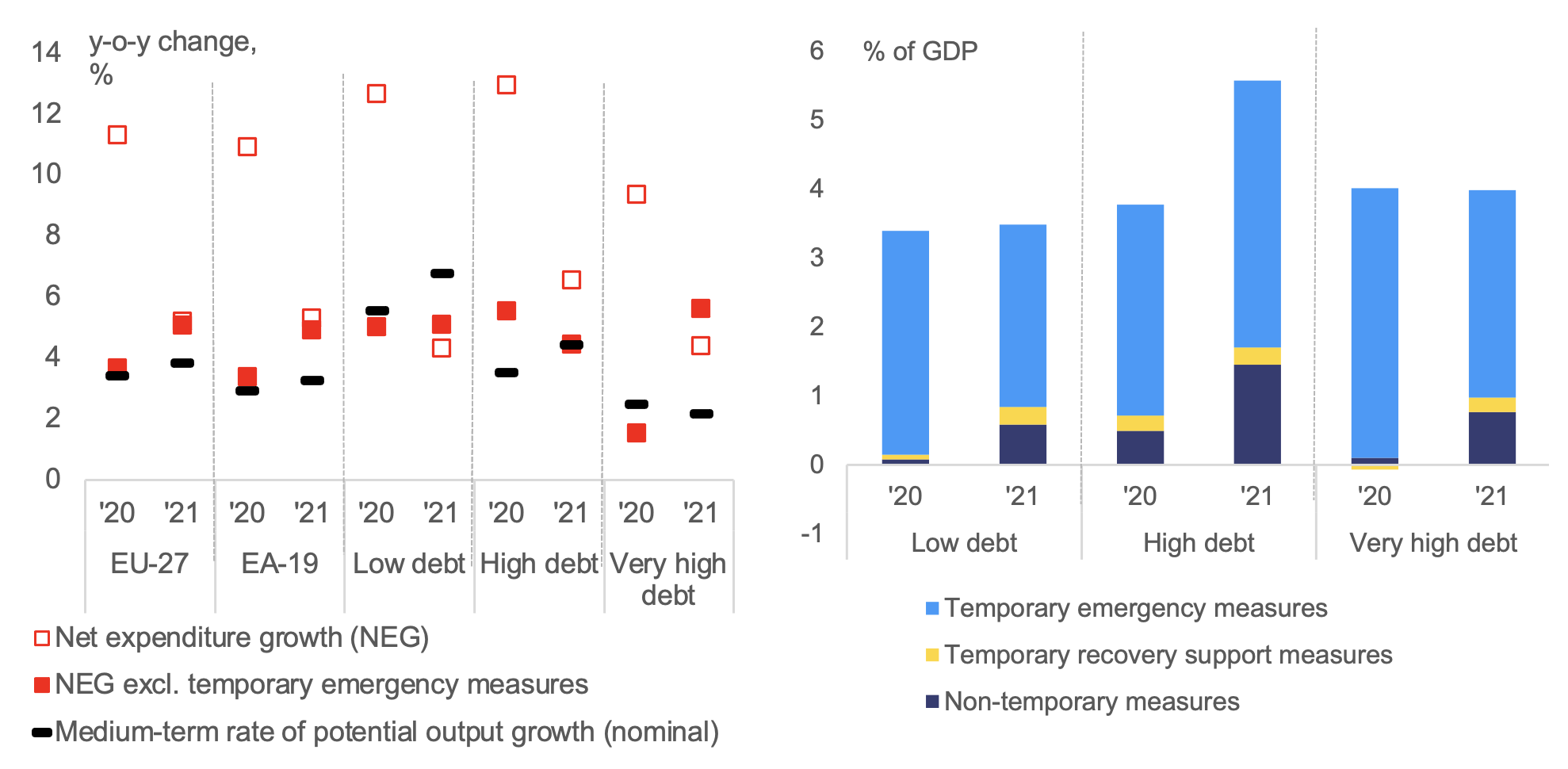The policy response of the EU and its member states to the deep economic recession caused by the Covid-19 pandemic has been widely praised as forceful and appropriate. Observers applauded the comeback of fiscal policy as an effective macroeconomic stabilisation tool. The response to the strong economic rebound in 2021 has received less attention, at least so far. This is unfortunate. The effectiveness of fiscal policy can only be appraised over a full cycle: the downturn and the upturn. In fact, the way economic policy in the EU member states reacted to the exceptional economic downturn in 2020 first and to the rebound in 2021 after, is a clear lesson in the underlying predicament of fiscal policymaking.
The events around 2020 and 2021 are obviously exceptional, but they are also characteristic of entrenched patterns, which over the years have given rise to criticism and tensions. In particular, the year 2021 underscores the temptation of governments to adjust expenditure plans upward during economic recoveries. Over time, this pattern has fuelled a clear ratcheting up effect on government debt in some EU countries, restricting their preparedness for subsequent economic shocks (EFB 2019).
Improved headline numbers mask worrying trends
When the Covid-19 pandemic struck in early 2020, economic commentators stirred up the usual alphabet soup of possible recoveries ranging from L, K, W to V. In hindsight, the V-shape prevailed: The sharp and deep downturn in 2020 was followed by a solid rebound in 2021, pushing annual real GDP in the EU virtually back to its pre-crisis level. The exact profile of the V varied from country to country – some rebounding faster than others – but was clearly visible across the board (Figure 1).
Figure 1 V-shaped recovery from the Covid crisis
Source: European Commission 2022 spring forecast
To safeguard sustainability, fiscal policy should be deployed symmetrically over the cycle: stimulate demand during downturns and withdraw support when the economy bounces back. This basic principle motivated the European Commission to address letters to EU Finance Ministers in September 2020. The letters called for targeted and temporary fiscal measures and for regular reviews of the fiscal response. The timing of the initiative was carefully chosen. The letters were posted while EU member states were finalising their budget plans for 2021 and when most forecasters anticipated a sharp upturn in economic activity towards the end of the year and the beginning of the next.
However, the Commission’s advice did not gain much traction. Although forecasters still anticipated a robust economic recovery in 2021 - mainly thanks to the expected rollout of vaccines and the related release of pent-up demand - a new wave of Covid infections fuelled a sense of downside risk and prompted several EU member states to extend existing fiscal measures and/or to propose new ones. As a result, the Commission’s assessment of draft budgetary plans at the end of November 2020 was mixed. On the one hand, it flagged that many planned measures did not appear to be temporary and advised high debt countries to preserve fiscal sustainability.
On the other hand, it referred to downside risks to the economic outlook calling for continued fiscal support.
On the face of it, concerns seem to have been unwarranted. Fiscal positions in 2021 surprised on the upside for two reasons: (i) on average, 2020 deficits turned out more than 1% of GDP lower, and (ii) nominal GDP growth in 2021 was two percentage points higher than expected at the time budget plans for 2021 had been finalised. So, was everything fine after all? Unfortunately, headline numbers are treacherous indicators. They tend to hide unpleasant truths. For starters, net of cyclical factors the 2021 budget balance deteriorated. Instead of gradually withdrawing fiscal support alongside the economic rebound, governments continued to run expansionary fiscal policies, especially in the euro area.
A more detailed analysis reveals the underlying and well-known practice of spending revenue windfalls. Largely unmentioned in official reports, in 2021 the tax content of economic activity exceeded forecasts by a significant margin. Nominal GDP growth of slightly more than 7% on the previous year generated an increase of government revenues of more than 9%. In normal years, government revenues broadly move in lockstep with economic activity.
Because of the exceptional nature of revenue windfalls, prudent policymakers would have welcomed the resulting improvement of headline balances by sticking as much as possible to original spending plans. After the unprecedented increase in government expenditure in 2020 of close to 8% in real terms - six times the long-term average – some moderation would have been justified. However, outturn data tell a different story. Several governments took advantage of higher revenues to further increase already very high expenditure levels.
Figure 2 Government expenditure in 2020 and 2021
Notes: Low debt = EU countries with government debt <= 60% of GDP (in 2011-2019 on average). High debt: EU countries with 60% of GDP < government debt <= 90% of GDP. Very high debt: EU countries with government debt > 90% of GDP. Net expenditure growth (NEG) refers to the growth rate of government expenditure, excluding interest expenditure, expenditure on EU programmes fully matched by EU funds, and the cyclical part of unemployment benefit expenditure, and is net of discretionary revenue measures and one-offs; investment expenditures are averaged over four years. The medium-term rate of potential GDP growth is in nominal terms calculated as the ten-year average of real potential output growth and the year-on-year rate of change of the GDP deflator. Temporary emergency measures support health systems and compensate workers and firms for pandemic-induced income losses; they exclude public investment. Temporary recovery support measures include public investment and other spending focused on ensuring a sustainable recovery from the recession caused by the Covid pandemic.
Source: European Commission, own calculations
To be perfectly clear, we are not arguing that EU member states should have launched ambitious consolidation programmes. However, if governments had stayed the original course in terms of expenditure plans, the headline deficit of the EU and the euro area would have been almost 2% of GDP lower, i.e. closer to 3% of GDP than the actual 5%. Especially countries with high and very high debt-to-GDP ratios rode the coattail of revenue windfalls by keeping expenditure growth well above sustainable rates in the long run. What makes this strategy particularly risky is that an important part of the extra expenditure implemented in 2021 was of a permanent nature (Figure 2). Needless to say, the revenue windfalls spent in 2021 would have come in handy in 2022 in the wake of the energy crisis caused by the Russian invasion of Ukraine. To be fair, not all EU member states are equally affected. Some managed to follow a more symmetric approach.
Policy considerations
When the Covid-19 pandemic struck in 2020, national fiscal policies reacted swiftly and forcefully. Member states agreed to massive fiscal expansions in record time. They were less agile when the economy rebounded sharply in 2021. Governments kept their foot on the fiscal accelerator on account of downside risks or pushed even harder taking advantage of revenue windfalls. As a result, the year 2021 confirmed patterns that are as entrenched as they are unfortunate.
First, government expenditure plans are not the anchor of fiscal policy they can and should be. When revenues turn out higher than assumed, there is a high probability they are spent, fully or partially, at least in some countries. Second, risk assessments around the economic outlook are consistently tilted to the downside. Since the onset of the EU fiscal framework at the end of the 1990s, the bi-annual macroeconomic projections of the European Commission have never identified a balance of risks tilted to the upside. Even in years of economic recovery, perceived risks have been mostly skewed to the downside.
Taken together, these two recurring patterns have driven the secular upward trend in government debt observed in some EU member states and raise questions about the scope of fiscal stabilisation. If economic conditions systematically disappoint to the downside, and windfalls are not saved, how can fiscal stabilisation be sustainable in the long run (EFB 2021, Larch et al. 2021)?
In the ongoing review of the EU’s economic governance framework some observers attribute the less-than-optimal fiscal performance in some member states to the complexity of the current set of fiscal rules, a complexity which, according to their narrative, hinders ownership. Although this view has attracted a growing number of followers, it still clashes with a simple yet important fact.
One straightforward way for national governments to circumnavigate the complexities of the current system would have been to follow the expenditure benchmark of the Stability and Growth Pact, i.e. keep government expenditure on a steady path predicated on a prudent rate of long-term economic growth, and let revenues fluctuate over the cycle. Sticking to such a simple and intuitive benchmark would not only have helped stabilise the economy, it would in most cases have ensured consistency with all the other rules of the Stability and Growth Pact.
And if it hadn’t, it would have been for fully justified reasons, for instance, in the course of a severe recession when deficits can and should temporarily go beyond the famous 3% of GDP threshold.
Yet, reality tells a different story. The expenditure benchmark of the Stability and Growth Pact, which charts out an intuitive and easy to communicate course for national fiscal policy, is the one rule of the Pact that governments tend to follow the least (Larch and Santacroce 2020). Other, less intuitive, and more pro-cyclical rules of the Stability and Growth Pact, seem to be preferred.
How can we reconcile this finding with the fact that in the ongoing reform debate most proposals attach their hope precisely on the simplicity of an expenditure benchmark? Why would member states follow a rule they apparently did not like so much until now? The answer seems to be that adjustment paths will be tailor-made, taking into account specificities of each country. If translated into a concrete reform of the Stability and Growth Pact, such an approach of bespoke adjustments would imply an important paradigm shift.
Until now, equal treatment was considered crucial in the design and implementation of the EU fiscal framework,
whereby equality of treatment was meant to be understood as contributions to macro-financial stability or even efforts to avoid negative externalities from national fiscal policies. This basic idea now seems to be replaced by one that defines fairness in terms of national abilities or preferences. Time will tell whether this paradigm shift will improve ownership of expenditure benchmarks and whether it will ensure a smooth functioning of the single currency area. It will certainly rekindle the everlasting and unavoidable discussion of how much risk sharing versus risk reduction there should be in the Economic and Monetary Union.
References
European Fiscal Board (2019), “Assessment of EU fiscal rules with a focus on the six and two-pack legislation”, August.
European Fiscal Board (2021), “2021 Annual Report”, Brussels.
Larch, M and S Santacroce (2020), “Numerical compliance with EU fiscal rules: The compliance database of the Secretariat of the European Fiscal Board”, 1 July.
Larch, M, D Kumps and A Cugnasca (2021), “Fiscal stabilisation in real time: An exercise in risk management”, Economic Modelling 99.
Price, R W R, T-T Dang and J Botev (2015), “Adjusting Fiscal Balances for the Business Cycle: New tax and expenditure estimates for OECD countries”, OECD Economics Department Working Paper No. 1275.





